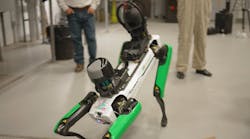Avangrid Pilots Mobile Robot Dog to Advance Substation Inspections with Artificial Intelligence
Avangrid, Inc. has announced a pilot project with Levatas and Boston Dynamics to advance substation inspections using artificial intelligence (AI) with the goal of increasing reliability for customers. This project will deploy a mobile robot called Spot modeled after a dog to complete visual and thermal inspections at two substations of its Connecticut subsidiary, United Illuminating (UI).
The pilot project will take place at UI’s Singer and East Shore substations and test a variety of AI models, developed by Levatas, to read analog gauges, record thermal images, and detect damaged equipment. To do so, the robot dog—nicknamed Sparky by the Avangrid team—is outfitted with a camera that has a 30 times optical zoom and an infrared camera capable of taking thermal readings to compare the transformer and breaker phases. There is also an option to attach an acoustic sensor that can detect, locate, and visualize changes in sound signatures, malfunctioning equipment, and other noise anomalies in real-time. The robot also has a core processor to enhance autonomous navigation and communications.
At the Singer substation, the project will test how quickly and accurately the robot can detect and read several of the substation’s analog gauges. At East Shore substation, the project will test the robot’s ability to inspect transformers, circuit breakers and capacitor banks. Initially the robot will be controlled by an onsite operator using a tablet, which can be used to both drive the robot and create autonomous missions. Avangrid is also working to install software that would allow for remote operation as well.
“It's amazing to see this technology, which was inconceivable a few years ago, in our hands bringing value and benefits to our customers,” said Catherine Stempien, Avangrid Networks President and CEO. “While there will be many benefits, most important is that we expect Sparky will increase the frequency of our substation inspections so that we can see how our equipment is functioning during different seasons, times of the day, and energy loads. With this increased amount of data, we will have the potential to proactively identify unknown issues and trends before they cause outages that impact our customers. This is a great example of innovation and technology helping us do more.”


